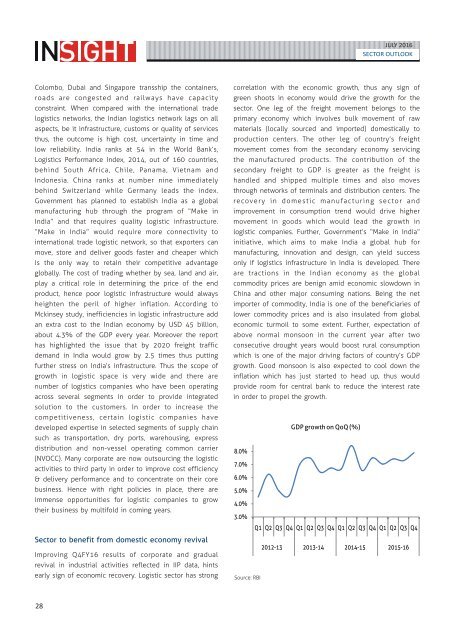You also want an ePaper? Increase the reach of your titles
YUMPU automatically turns print PDFs into web optimized ePapers that Google loves.
JULY <strong>2016</strong><br />
SECTOR OUTLOOK<br />
Colombo, Dubai and Singapore transship the containers,<br />
roads are congested and railways have capacity<br />
constraint. When compared with the international trade<br />
logistics networks, the Indian logistics network lags on all<br />
aspects, be it infrastructure, customs or quality of services<br />
thus, the outcome is high cost, uncertainty in time and<br />
low reliability. India ranks at 54 in the World Bank’s,<br />
Logistics Performance Index, 2014, out of 160 countries,<br />
behind South Africa, Chile, Panama, Vietnam and<br />
Indonesia. China ranks at number nine immediately<br />
behind Switzerland while Germany leads the index.<br />
Government has planned to establish India as a global<br />
manufacturing hub through the program of “Make in<br />
India” and that requires quality logistic infrastructure.<br />
“Make in India” would require more connectivity to<br />
international trade logistic network, so that exporters can<br />
move, store and deliver goods faster and cheaper which<br />
is the only way to retain their competitive advantage<br />
globally. The cost of trading whether by sea, land and air,<br />
play a critical role in determining the price of the end<br />
product, hence poor logistic infrastructure would always<br />
heighten the peril of higher inflation. According to<br />
Mckinsey study, inefficiencies in logistic infrastructure add<br />
an extra cost to the Indian economy by USD 45 billion,<br />
about 4.3% of the GDP every year. Moreover the report<br />
has highlighted the issue that by 2020 freight traffic<br />
demand in India would grow by 2.5 times thus putting<br />
further stress on India’s infrastructure. Thus the scope of<br />
growth in logistic space is very wide and there are<br />
number of logistics companies who have been operating<br />
across several segments in order to provide integrated<br />
solution to the customers. In order to increase the<br />
competitiveness, certain logistic companies have<br />
developed expertise in selected segments of supply chain<br />
such as transportation, dry ports, warehousing, express<br />
distribution and non-vessel operating common carrier<br />
(NVOCC). Many corporate are now outsourcing the logistic<br />
activities to third party in order to improve cost efficiency<br />
& delivery performance and to concentrate on their core<br />
business. Hence with right policies in place, there are<br />
immense opportunities for logistic companies to grow<br />
their business by multifold in coming years.<br />
Sector to benefit from domestic economy revival<br />
Improving Q4FY16 results of corporate and gradual<br />
revival in industrial activities reflected in IIP data, hints<br />
early sign of economic recovery. Logistic sector has strong<br />
correlation with the economic growth, thus any sign of<br />
green shoots in economy would drive the growth for the<br />
sector. One leg of the freight movement belongs to the<br />
primary economy which involves bulk movement of raw<br />
materials (locally sourced and imported) domestically to<br />
production centers. The other leg of country’s freight<br />
movement comes from the secondary economy servicing<br />
the manufactured products. The contribution of the<br />
secondary freight to GDP is greater as the freight is<br />
handled and shipped multiple times and also moves<br />
through networks of terminals and distribution centers. The<br />
recovery in domestic manufacturing sector and<br />
improvement in consumption trend would drive higher<br />
movement in goods which would lead the growth in<br />
logistic companies. Further, Government’s “Make in India”<br />
initiative, which aims to make India a global hub for<br />
manufacturing, innovation and design, can yield success<br />
only if logistics infrastructure in India is developed. There<br />
are tractions in the Indian economy as the global<br />
commodity prices are benign amid economic slowdown in<br />
China and other major consuming nations. Being the net<br />
importer of commodity, India is one of the beneficiaries of<br />
lower commodity prices and is also insulated from global<br />
economic turmoil to some extent. Further, expectation of<br />
above normal monsoon in the current year after two<br />
consecutive drought years would boost rural consumption<br />
which is one of the major driving factors of country’s GDP<br />
growth. Good monsoon is also expected to cool down the<br />
inflation which has just started to head up, thus would<br />
provide room for central bank to reduce the interest rate<br />
in order to propel the growth.<br />
GDP growth on QoQ (%)<br />
8.0%<br />
7.0%<br />
6.0%<br />
5.0%<br />
4.0%<br />
3.0%<br />
Q1 Q2 Q3 Q4 Q1 Q2 Q3 Q4 Q1 Q2 Q3 Q4 Q1 Q2 Q3 Q4<br />
2012-13 2013-14 2014-15 2015-16<br />
Source: RBI<br />
28




